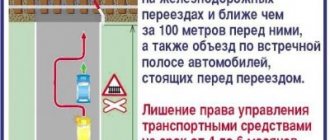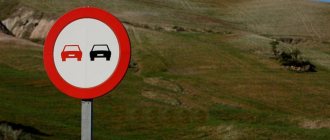In most cases, in the summer, the banks of rivers, lakes and other bodies of water are filled with vehicles with vacationers. If a barrier is not installed and a parking area is not allocated, cars sometimes stop right next to the water.
Despite all the apparent fun, vacationers can wash their car and settle down for the night next to a pond. Meanwhile, this fact is an administrative offense.
The driver may be punished and the holiday ruined. According to current legislation, there is a ban on parking and parking near bodies of water.
What is a water protection zone?
The definition of a water protection zone is given by Art. 65 VK RF. According to its norms, this term refers to the territory that is adjacent to the boundaries of the reservoir , and in which a special regime of activity applies. The purpose of this regime is to prevent:
- water pollution;
- depletion of water sources;
- disruption of habitat for aquatic plants and animals.
The sign is installed on a white pole near a pond.
The width of the water protection zone varies depending on the status of the reservoir and ranges from 30 to 500 m . The exact minimum size established for rivers, reservoirs, lakes and seas can be found in the VK of the Russian Federation, but there is one exception - Baikal. A special status has been established for it, and the width of the security zone is regulated by Art. 3 Federal Law “On the protection of Lake Baikal”.
There are bodies of water for which a protection zone is not established. These are rivers and streams taken into sewers. If normal regime were in effect in these facilities, life in many cities would be extremely difficult.
Difference from coastal protection strip
The water protection zone also includes a protective strip of water bodies. This is the part of the zone that is directly adjacent to the shoreline of the reservoir. Sometimes both of these concepts coincide: for example, for streams and rivers with a length from source to mouth of less than 10 km, the water protection zone and the protective strip are one and the same.
The main difference between a water protection zone and a protective strip is the greater severity of the regime. While it is still possible to carry out at least some kind of economic activity in the water protection zone, practically nothing is allowed in the protective strip - neither plowing, nor dumping soil, nor grazing livestock.
Where can I park my car on the shore of a pond?
The width of the water protection zone for rivers, streams, canals, lakes, reservoirs that are located outside cities, villages and other populated areas depends on the boundary of the water body. It depends on the source of rivers or streams, for example:
- if a river or stream is 10 kilometers long, then the width of the water protection zone is fifty meters;
- from ten to fifty kilometers - in the amount of one hundred meters;
- from fifty kilometers or more - in the amount of two hundred meters.
It turns out that you can park your car on the banks of the Volga or Kama only at a distance of 200 meters.
There are exceptions. For example, if a reservoir has a special valuable fishery value - it is a place for spawning, feeding, wintering of fish and other aquatic biological resources, then in any case, regardless of the slope of the adjacent lands, the width of the coastal zone will be 200 meters!
If you are looking for car parking within a city, village or village, then you need to take into account that in the presence of centralized storm drainage systems and embankments, the boundaries of coastal protective strips coincide with the parapets of the embankments. The width of the water protection zone in such areas is established from the embankment parapet.
If there is no embankment, then the width of the water protection zone or coastal protective strip is measured from the location of the river or lake bank.
Is it possible to drive up to the river by car and is parking allowed?
Regarding transport, Art. 65 of the RF Military Code directly establishes the following restriction: in the water protection zone, and especially on the coastal protective strip, you can neither stop nor drive through .
The only exception provided for in paragraphs. 4 hours 15 tbsp. 65 of the Criminal Code of the Russian Federation - these are cases when vehicles are moving and standing either on roads or on specially equipped areas with hard surfaces. The logic of this rule is obvious:
- A heavy machine standing on loose soil can cause the soil to gradually slide with its weight. This, in turn, will lead to crushing, silting and waterlogging of the reservoir.
- A vehicle, even one that meets environmental standards for transport, is a source of pollution.
Laws regulating penalties for violations in the water protection zone in 2019
Today, the main laws regulating parking, car parking and other violations in water protection zones, as well as determining the degree of responsibility, are: Federal Law 74 of 06/03/2006 - Water Code of the Russian Federation and Federal Law 195 of December 30, 2001 - Code of the Russian Federation on Administrative Offenses .
Article 65 of the Water Code of the Russian Federation provides an explanation of violations within the boundaries of water protection zones, namely clause 4, part 15 of art. 65 of the RF CC prohibits the movement and parking of vehicles within established zones, with the exception of special vehicles. And Article 68 of the RF CC says that liability can be not only administrative, but also criminal.
Article 8.42 of the Code of Administrative Offenses of the Russian Federation clearly regulates the issue of access and location of vehicles near the river and determines the punishment for violating the rules.
Thus, on the basis of legislation, the use of the coastal strip of a water body in violation of the law is subject to fines:
- for individuals - from 3000 to 4500 rubles;
- for officials - from 8,000 to 12,000 rubles;
- for legal entities - from 200,000 to 400,000 rubles.
Use in violation of sanitary protection zones is also punishable by a fine , but it will depend on which zone you are violating:
| Intruder | 3rd belt ZSO/Fine in t.rub. | 2nd belt ZSO/Fine in t.rub. | 1st belt ZSO/Fine in t.rub. |
| Individual | from 3000 to 5000 | from 5000 to 10000 | from 10000 to 20000 |
| Executive | from 10000 to 15000 | from 20000 to 40000 | from 50000 to 80000 |
| Entity | from 10000 to 20000 | from 50000 to 80000 | from 600000 to 1000000 |
For individual entrepreneurs, the fine for improper use of the 1st and 2nd zones of the sanitary protection zone is equal to that of officials or an administrative suspension of their activities is imposed for a period of 90 days.
Reference! Article 8.13 of the Code of Administrative Offenses of the Russian Federation regulates the issue of violation of rules for the protection of water bodies. This standard will be applied in case of common violations: car washing, pollution of the shore of a reservoir.
Penalties for violations of the requirements under this article will be as follows:
- Individual - from 1500 to 2000 rubles.
- Official - from 50,000 to 80,000 rubles.
- Legal entity - from 150,000 to 300,000 rubles.
How many meters away can you park your car from the river? Distance to the reservoir
If there are no signs nearby, then you can comply with the law if you are guided by the following table:
| Type of reservoir | Zone width, m |
| Streams and rivers less than 10 km long | 50 |
| Rivers from 10 to 50 km | 100 |
| Rivers more than 50 km long | 200 |
| Lakes and reservoirs with an area of more than 0.5 square meters. km | 50 |
| Flowing reservoirs on streams and rivers | Like a stream or river on which a dam is built |
| Seas | 500 |
| Channels | By width of the right of way |
| Lake Baikal | In accordance with decisions of local authorities, but not less than 50 m |
In specific examples it will look like this:
- Residents of Voronezh enjoy relaxing on the sandy beaches of the Usmanka River (the lower reaches of the Usman River). According to the map, the length of this river is 151 km, which means that the car must be parked no closer than 200 m.
- A resident of Stary Oskol decided to swim in the Ublya River, which flows near the city. The length of this river is 51 km, which means you can park no closer than 100 m from the shoreline.
- The length of the Volga River is 3.53 km, and the water protection zone is 50 meters.
The width of the protection zone and its border are legally different things. Therefore, you must first focus on the warning signs near the shores of the reservoir. But in any case, being at a distance from the shore less than indicated in the table will be an offense.
Fine for entry and parking (parking) near a reservoir
A driver who enters a water protection zone and parks his car there will have to face the consequences provided for in Part 1 of Art. 8.42 Code of Administrative Offenses of the Russian Federation. It provides for only one type of punishment - a fine. Its size will be:
- For ordinary citizens – from 3 to 4.5 thousand rubles.
- For officials – already from 8 to 12 thousand.
- For legal entities (for example, for a company that organized parking in the wrong place) - from 200 to 400 thousand rubles.
From a formal point of view, even a bicycle is considered a vehicle. But in practice, cyclists are usually not fined. Hunters who cross forest streams in vehicles are also rarely brought to justice. Finally, fines are usually not imposed in cases where the offense is minor: for example, a fisherman brought a motor boat on a car trailer, unloaded it onto the water and immediately drove the car outside the water protection zone.
If you believe that you have been fined illegally, contact our auto lawyer and get a free consultation. And be sure to read how to appeal a traffic police fine.
Reasons for the ban
Experienced tourists know: the closer the water, the better the picnic. But today, a motorist has no right to drive closer than 200 meters to the sea, river or lake. Iron horses cause enough damage to the environment on land, what will happen if they are also allowed to go to water?
Meanwhile, the draft amendments to the Water Code propose to reduce the prohibited zone for motorists along the banks to 50 meters. The Legislative Assembly of the Orenburg Region came up with the initiative to bring the parking lots of motorized tourists closer to the water. The project has been submitted to the State Duma, and now the relevant committee is collecting feedback.
As lawyer Alexey Sikaylo clarifies, the document deals primarily with so-called wild beaches and parking lots.
“The parking restriction within the boundaries of water protection zones does not apply to specially equipped places with a hard surface,” says Alexey Sikaylo. “Thus, if there is an official campsite with a paved area near the shore, no one will stop you from spending the night there as many times as you like. This is what campsites are created for.”
If there is a highway along the coast, then it is not forbidden to drive along it. Why else was he held there?
“But if you have taken a car or a motorcycle along some animal paths to a place remote from civilization, then you have no right to drive closer than 200 meters to a body of water,” says the lawyer.
You cannot park or move along the shore in the two-hundred-meter zone. The development of a network of campsites would solve many problems. But the developers of the initiative complain that even close to civilization, nature is not always equipped for recreation on wheels.
Today, a motorist has no right to drive closer than 200 meters to the shore. The initiative proposes to reduce this distance to 50 meters
“However, within the boundaries of the water protection zones of most reservoirs and watercourses there are no roads or equipped parking areas with hard surfaces,” the explanatory note says. “A similar situation is developing on all major rivers and lakes of the country, while people come to relax for more than one day, with children, with a lot of cargo.” But today you need to leave your cars far from wild beaches. Accordingly, the tourist has to choose: a tent on the shore, a car far away in the bushes, or a tent near the car, but then it’s a long walk to the water. According to the project developers, there will be no harm from reducing the water protection zone.
“The adoption of appropriate changes will help increase the accessibility of water bodies for citizens and will not lead to pollution, clogging, siltation of these water bodies and depletion of their waters,” the explanatory note says.
According to experts, today a driver faces a fine of 3 to 4.5 thousand rubles for violating the water protection zone with his wheels. “On a human level, the desire of the project initiators to allow parking as close to the shore as possible is quite understandable,” says Alexey Sikaylo. - Of course, it’s much more convenient to park the car next to the water and immediately set up camp, who’s going to argue?
But the restrictions were introduced for a reason. To reduce the water protection zone, strong arguments are needed; it is not enough to simply say that there will be no harm to the environment. Show scientific calculations, give the opinion of experts. We must protect nature, this is not discussed. Therefore, the initiative requires careful study. In general, we need to cultivate a tourism culture based on respect for nature.”
By the way, in some regions there are separate fines for going on the ice. Because fishermen and motor tourists do not deny themselves the opportunity to not only violate the border of the water protection zone, but literally overflow the banks.
At the beginning of the year, in Primorye, in Voevoda Bay on Russky Island, 29 fishermen’s cars went under the ice after setting up an impromptu parking lot on the frozen sea. For cars that have been at the bottom of the sea in Primorye they even came up with a term: “sinkhole”. And protocols were drawn up against the owners of the “toplyakov”: according to the regional law, the fine for going on the ice ranges from 1 to 3 thousand rubles.
In Tatarstan, a criminal case was opened against a driver who decided to take a car ride on the ice of the Kama River with a friend. A few hundred meters from the shore, the car drove into a wormwood. The driver managed to escape, but the passenger drowned. Now the car owner will have to answer under the Criminal Code article “Causing death by negligence.”
How are they
In many Western countries, parking on ice or near bodies of water is not prohibited by law. So, for example, until recently, guests of the Winterfest ice sculpture festival, which takes place in Switzerland, left their cars right on the ice of Lake Geneva. However, this tradition had to be said goodbye in 2021, when 15 cars ended up in the water due to cracked ice. Only five were recovered. Meteorologists then attributed the incident to abnormally high winter temperatures. Therefore, two years later, before the start of the next festival, its organizers were forced to post a warning on their website: no parking on the ice.
Prepared by Diana Kovaleva
Who can be held accountable for violating the water protection zone?
Employees of the following organizations have the right to hold administratively accountable for parking near the shore of a reservoir:
- Rosprirodnadzor , and specifically water protection inspectors.
- Ministry of Internal Affairs of the Russian Federation (usually a traffic police inspector).
In the water protection zone outside of roads and parking lots, parking of only special vehicles is permitted and only in accordance with the rules in force for it. Therefore, if an inspector arrives in an ordinary car, he himself will break the law.
Places where parking is allowed near bodies of water
Near the shore of a river, lake or sea, vehicle access to water is possible only in the following places:
- On the side of the road if it runs near the coast.
- In special equipped parking lots with hard surfaces. Even if it is placed in violation, the problem will be with the one who built it, and not with the driver.
- Beyond the line limiting the water protection zone.
When using the latter method, you should focus primarily on prohibition signs.
The absence of signs does not mean that parking is allowed.
What is prohibited for drivers of any vehicles in the water protection zone?
- Movement and parking of vehicles (except for special vehicles), unless cars and other vehicles move or park in specially equipped places with a hard surface - asphalt, for example;
- Place gas stations, warehouses of fuel and lubricants (except for cases where gas stations, warehouses of fuel and lubricants are located in the territories of ports, shipbuilding and ship repair organizations, infrastructure of inland waterways, subject to compliance with the requirements of legislation in the field of environmental protection and the Water Code ), service stations used for technical inspection and repair of vehicles, and vehicle washing.
All articles by the author: Sergey Ivanov











